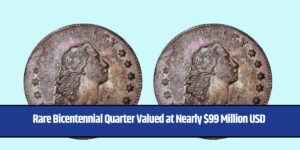Owning a 1943 Lincoln bronze cent—a penny worth up to $1.7 million—might sound like a dream, but for a lucky few collectors, it’s a reality. This extraordinary coin, born of a minting error during World War II, has become one of the most sought-after treasures in U.S. numismatic history. Its rarity, historical context, and unique features make it an icon in the coin-collecting world. Here’s a closer look at the fascinating story behind this coin and how to identify one.
The History Behind the 1943 Lincoln Bronze Cent
In 1943, the U.S. Mint made a historic switch in penny production, replacing copper (bronze) with zinc-coated steel to conserve copper for wartime needs, such as ammunition and military equipment. However, a small number of leftover bronze blanks accidentally made their way into the presses, producing the rare 1943 bronze pennies.
These error coins went unnoticed initially and were discovered years later. One of the first famous finds was in 1947 when Don Lutes Jr., a teenager from Massachusetts, received one in his school cafeteria change. Lutes kept the coin for decades, eventually selling it at auction in 2018 for $204,000. The highest price ever recorded for a 1943 bronze cent was $1.7 million, achieved in 2010.
Why Is the 1943 Bronze Cent So Valuable?
1. Rarity
Only 15 to 20 genuine examples of the 1943 bronze cent are known to exist, making it one of the rarest U.S. coins.
2. Minting Error
The use of bronze blanks during the steel penny production run was an unintentional error, and coins with such material mismatches are considered exceptionally rare and valuable.
3. Historical Significance
Produced during World War II, this penny reflects a time of great change and sacrifice in the United States. Collectors prize items from this era for their connection to history.
Characteristics of the 1943 Lincoln Bronze Cent
Identifying a genuine 1943 bronze penny requires careful examination. Below are the defining features of this rare coin:
| Characteristic | Details |
|---|---|
| Composition | 95% copper (bronze), unlike steel coins. |
| Weight | Approximately 3.11 grams (bronze); heavier than steel pennies. |
| Color | Brownish hue, distinct from the grayish tone of steel. |
| Magnet Test | Not magnetic; steel pennies will stick to a magnet. |
| Design | Standard Lincoln wheat design (1909–1958). |
The magnet test is the simplest way to distinguish a bronze penny from its steel counterparts. Bronze is non-magnetic, whereas steel is magnetic and will adhere to a magnet.
How a 1943 Bronze Penny Reached $1.7 Million
Several factors contribute to the immense value of this penny:
1. Condition
The condition of a coin is a critical factor in determining its value. Coins in mint state or uncirculated condition, with minimal wear and preserved luster, command the highest prices.
2. Provenance
Coins with a well-documented history or notable previous owners often fetch premium prices. For instance, Don Lutes Jr.’s bronze cent was particularly valuable because of its fascinating backstory.
3. Collector Demand
The 1943 bronze cent’s rarity, coupled with its historical and error status, makes it highly desirable among collectors. The growing demand for such unique coins continues to push prices higher.
Authenticating and Selling a 1943 Bronze Penny
If you suspect you have a 1943 bronze penny, professional authentication is essential. Trusted organizations like the Professional Coin Grading Service (PCGS) or the Numismatic Guaranty Corporation (NGC) can confirm its authenticity and assign a grade based on condition.
Where to Sell Your Coin
Rare coins like the 1943 bronze cent are best sold through specialized auction houses such as:
- Heritage Auctions
- Stack’s Bowers Galleries
- Sotheby’s
These venues attract serious collectors who are willing to pay top dollar for rare finds.
Avoiding Counterfeits
Due to the high value of the 1943 bronze penny, counterfeits are common. To protect yourself:
- Perform a Magnet Test: Steel pennies will stick to a magnet, while bronze pennies will not.
- Seek Professional Grading: Organizations like PCGS and NGC use advanced techniques to authenticate coins.
- Beware of Altered Coins: Some counterfeits are steel pennies coated with copper to mimic bronze.
Conclusion: A Treasure of Numismatic History
The 1943 Lincoln bronze cent is more than a rare coin—it’s a piece of history from a time of immense change in the United States. Its story, scarcity, and unique characteristics make it one of the most coveted coins in numismatics. If you believe you own one, professional authentication could turn your find into a life-changing treasure.
FAQ:
Why were 1943 pennies made of steel?
During World War II, the U.S. Mint used steel for pennies to conserve copper for wartime needs, such as ammunition production.
How many 1943 bronze pennies exist?
There are an estimated 15 to 20 genuine examples known to exist.
How can I test if my 1943 penny is bronze?
The magnet test is a quick way to check. Bronze is non-magnetic, so the coin will not stick to a magnet, unlike steel pennies.
What’s the most a 1943 bronze penny has sold for?
The record price for a 1943 bronze penny is $1.7 million, set in 2010.
How do I get my coin authenticated?
Send your coin to a reputable grading service like PCGS or NGC for professional authentication and grading.

















